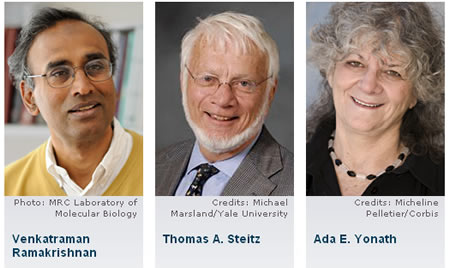Nobel Prize Chemistry for an American-Indian
 |
| The Nobel Laureates for CHemistry 2009, Photos: Nobel Prize |
The Royal Swedish Academy of Sciences has decided to award the Nobel Prize in Chemistry for 2009 jointly to
Venkatraman Ramakrishnan, MRC Laboratory of Molecular Biology, Cambridge, United Kingdom
Thomas A. Steitz, Yale University, New Haven, CT, USA
Ada E. Yonath, Weizmann Institute of Science, Rehovot, Israel
"for studies of the structure and function of the ribosome"
So much of the Nobel Laureates are from American. One thing to Cherish is Mr. Venkatraman Ramakrishna is an India born (Tamil Nadu) . So wen can add one more to our Nobel Laureates ( And India Government now follow up by giving Bharat Ratna to Sri Venkatraman - Many of our Nobel Laureates got Nobel Prize as foreign citizens barring Sri Rabindranath Tagore, Sir C.V.Raman) .
Technicalities
The Nobel Prize in Chemistry for 2009 awards studies of one of life's core processes: the ribosome's translation of DNA information into life. Ribosomes produce proteins, which in turn control the chemistry in all living organisms. As ribosomes are crucial to life, they are also a major target for new antibiotics.
This year's Nobel Prize in Chemistry awards Venkatraman Ramakrishnan, Thomas A. Steitz and Ada E. Yonath for having showed what the ribosome looks like and how it functions at the atomic level. All three have used a method called X-ray crystallography to map the position for each and every one of the hundreds of thousands of atoms that make up the ribosome.
Inside every cell in all organisms, there are DNA molecules. They contain the blueprints for how a human being, a plant or a bacterium, looks and functions. But the DNA molecule is passive. If there was nothing else, there would be no life.
The blueprints become transformed into living matter through the work of ribosomes. Based upon the information in DNA, ribosomes make proteins: oxygen-transporting haemoglobin, antibodies of the immune system, hormones such as insulin, the collagen of the skin, or enzymes that break down sugar. There are tens of thousands of proteins in the body and they all have different forms and functions. They build and control life at the chemical level.
An understanding of the ribosome's innermost workings is important for a scientific understanding of life. This knowledge can be put to a practical and immediate use; many of today's antibiotics cure various diseases by blocking the function of bacterial ribosomes. Without functional ribosomes, bacteria cannot survive. This is why ribosomes are such an important target for new antibiotics.
This year's three Laureates have all generated 3D models that show how different antibiotics bind to the ribosome. These models are now used by scientists in order to develop new antibiotics, directly assisting the saving of lives and decreasing humanity's suffering.
Source : Nobelprize.ORG
If you want to know more you can download the Official document Nobel Prize Foundation released for Public here (For Downloading just right click and select "Save link content as.." or "Save Target as.." ,depends on browser )
Laurels to the Laureate
President Pratibha Patil today congratulated India-born (Now an American Citizen) scientist Professor Venkatraman Ramakrishnan for jointly winning this year’s Nobel prize for Chemistry.
In her message, Ms. Patil said she was very proud to hear of the news and was happy that Dr. Ramakrishnan’s pursuit of understanding the structure and functioning of the ribosome has been recognised.
Congress President Sonia Gandhi today extended warm greetings to India-born scientist
Professor Venkatraman Ramakrishnan for winning the prestigious Chemistry Nobel prize for this year.
In her message, Ms Gandhi said Ramakrishnan has made the entire country proud with his pioneering work which has won him the most coveted recognition.
